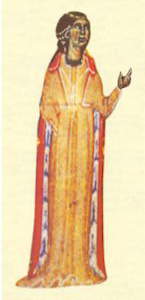
A troubadour was a composer and performer of Old Occitan lyric poetry during the High Middle Ages (1100–1350). Since the word troubadour is etymologically masculine, a female troubadour is usually called a trobairitz.

Arnaut Daniel was an Occitan troubadour of the 12th century, praised by Dante as "the best smith" and called a "grand master of love" by Petrarch. In the 20th century he was lauded by Ezra Pound in The Spirit of Romance (1910) as the greatest poet to have ever lived.

Bertran de Born was a baron from the Limousin in France, and one of the major Occitan troubadours of the twelfth century.

Peire Cardenal was a troubadour known for his satirical sirventes and his dislike of the clergy. Ninety-six pieces of his remain, a number rarely matched by other poets of the age.

Rigaut de Berbezilh was a troubadour of the petty nobility of Saintonge. He was a great influence on the Sicilian School and is quoted in the Roman de la Rose. About fifteen of his poems survive, including one planh and nine or ten cansos. His name is sometimes given as Richart or Richartz.
The canso or canson or canzo was a song style used by the troubadours. It was, by far, the most common genre used, especially by early troubadours, and only in the second half of the 13th century was its dominance challenged by a growing number of poets writing coblas esparsas.

The Comtessa de Dia, possibly named Beatritz or Isoarda, was a trobairitz.
Tibors de Sarenom is the earliest attestable trobairitz, active during the classical period of medieval Occitan literature at the height of the popularity of the troubadours.

Raimon Jordan was a Toulousain troubadour and the viscount of Saint-Antonin in the Rouergue near the boundary with Quercy.

Peirol or Peiròl was an Auvergnat troubadour who wrote mostly cansos of courtly love in the late twelfth and early thirteenth centuries. Thirty-four surviving poems written in Occitan have been attributed to him; of these, seventeen have surviving melodies. He is sometimes called Peirol d'Auvergne or Peiròl d'Auvèrnha, and erroneously Pierol.

The (Lo) Monge de Montaudon, born Pèire de Vic, was a nobleman, monk, and troubadour from the Auvergne, born at the castle of Vic-sur-Cère near Aurillac, where he became a Benedictine monk around 1180. According to his vida, he composed "couplets while he was in the monastery and sirventes on subjects that were popular in the region."

Peire d'Alvernhe or d'Alvernha was an Auvergnat troubadour with twenty-one or twenty-four surviving works. He composed in an "esoteric" and "formally complex" style known as the trobar clus. He stands out as the earliest troubadour mentioned by name in Dante's Divine Comedy.

Uc de Saint Circ or Hugues (Hugh) de Saint Circq was a troubadour from Quercy. Uc is perhaps most significant to modern historians as the probable author of several vidas and razos of other troubadours, though only one of Bernart de Ventadorn exists under his name. Forty-four of his songs, including fifteen cansos and only three canso melodies, have survived, along with a didactic manual entitled Ensenhamen d'onor. According to William E. Burgwinkle, as "poet, biographer, literary historian, and mythographer, Uc must be accorded his rightful place as the 'inventor' (trobador) of 'troubadour poetry' and the idealogical trappings with which it came to be associated."

Daude, Deude, Daurde, or Daudé de Pradas was a troubadour from Prades-Salars in the Rouergue not far from Rodez. He lived to an old age and left behind seventeen to nineteen cansos, including twelve on courtly love, three about sexual conquest, one tenso, one planh, and a religious song. Only one melody of his entire oeuvre has survived.

Berenguier de Palazol, Palol, or Palou was a Catalan troubadour from Palol in the County of Roussillon. Of his total output twelve cansos survive, and a relatively high proportion—eight—with melodies.

Peire Raimon de Tolosa was a troubadour from the merchant class of Toulouse. He is variously referred to as lo Viellz and lo Gros, though these are thought by some to refer to two different persons. On the other hand, lo Viellz could refer to his being of an early generation of troubadours. Eighteen of Peire Ramon's poems survive, one canso with a melody.

Uc, Uco, or Ugo de Pena or Penna was a troubadour of the late 12th and early 13th centuries. He left behind three cansos and no music.
Gavaudan was a troubadour and hired soldier at the courts of both Raymond V and Raymond VI of Toulouse and later on in Castile. He was from Gévaudan, as his name implies. He wrote moralising lyrics, either religious or political, and ten of his works survive, including five sirventes, two pastorelas, one canso, one planh for an anonymous domna (lady), and one Crusade song. He is sometimes clumped in a primitive Marcabrunian "school" of poetry alongside Bernart Marti, Bernart de Venzac, and Peire d'Alvernhe. He developed a hermetic style, combining elements of the trobar ric and trobar clus.

Raimon de (las) Salas or la Sala was a Provençal troubadour probably of the 1220s/1230s. His short vida survives. He left behind four or five poems, but he must have composed more, since he is vida records his composition of cansos, albas, and retroensas. Along with Ferrari da Ferrara, he is the only troubadour known to have tried his hand at the retroensa.
Raimon de Cornet was a fourteenth-century Toulousain priest, friar, grammarian, poet, and troubadour. He was a prolific author of verse; more than forty of his poems survive, most in Occitan but two in Latin. He also wrote letters, a didactic poem, a grammar, and some treatises on computation. He was the "last of the troubadours" and represented l'esprit le plus brillant of the "Toulousain School". He appears in contemporary documents with the titles En and Frare.

















